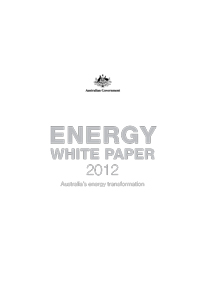Energy White Paper 2012
On 8 November 2012, the Australian Government released the 'Energy White Paper - Australia's Energy Transformation'. The 2012 Energy White Paper sets out the Australian Government's strategic policy framework to guide Australia's energy transformation to a cleaner and more productive energy economy. The central objective of the Energy White Paper is to 'provide the settings to deliver secure, reliable, clean, competitively priced energy to consumers; while building our national wealth through the safe and sustainable development of our energy resources'. In seeking to meet this challenge, 'the Australian Government is committed to open and transparent markets that allow competitive pricing, efficient resource allocation and innovation that delivers benefits to consumers and the nation. It is also important that all (Australian) governments maintain an attractive investment environment through efficient, timely and consistent national planning, approval and regulatory processes.'
The Energy White Paper contains significant analysis, data and modelling in relation to energy security, including liquid fuels security, and also contains significant information on the structure and operation of the liquid fuels industry.
Some key highlights in the 2012 Energy White Paper in relation to Liquid Fuels include the following:
- 'Liquid fuel security is assessed as high trending to moderate over the longer term.'
- 'Australian liquid fuel markets are functioning efficiently and effectively and are well placed to meet future needs.'
- 'Projected reductions in our crude oil production and refining capacity will mean that demand will increasingly be met by imports of crude oil and refined product. This is not considered to affect our liquid fuel security because we have ready access to mature, diverse and reliable international supply chains and robust market governance and emergency response arrangements.'
- 'Announced refinery closures will occur on the basis of an orderly transition to increase import capacity to ensure continuity of supply.'
